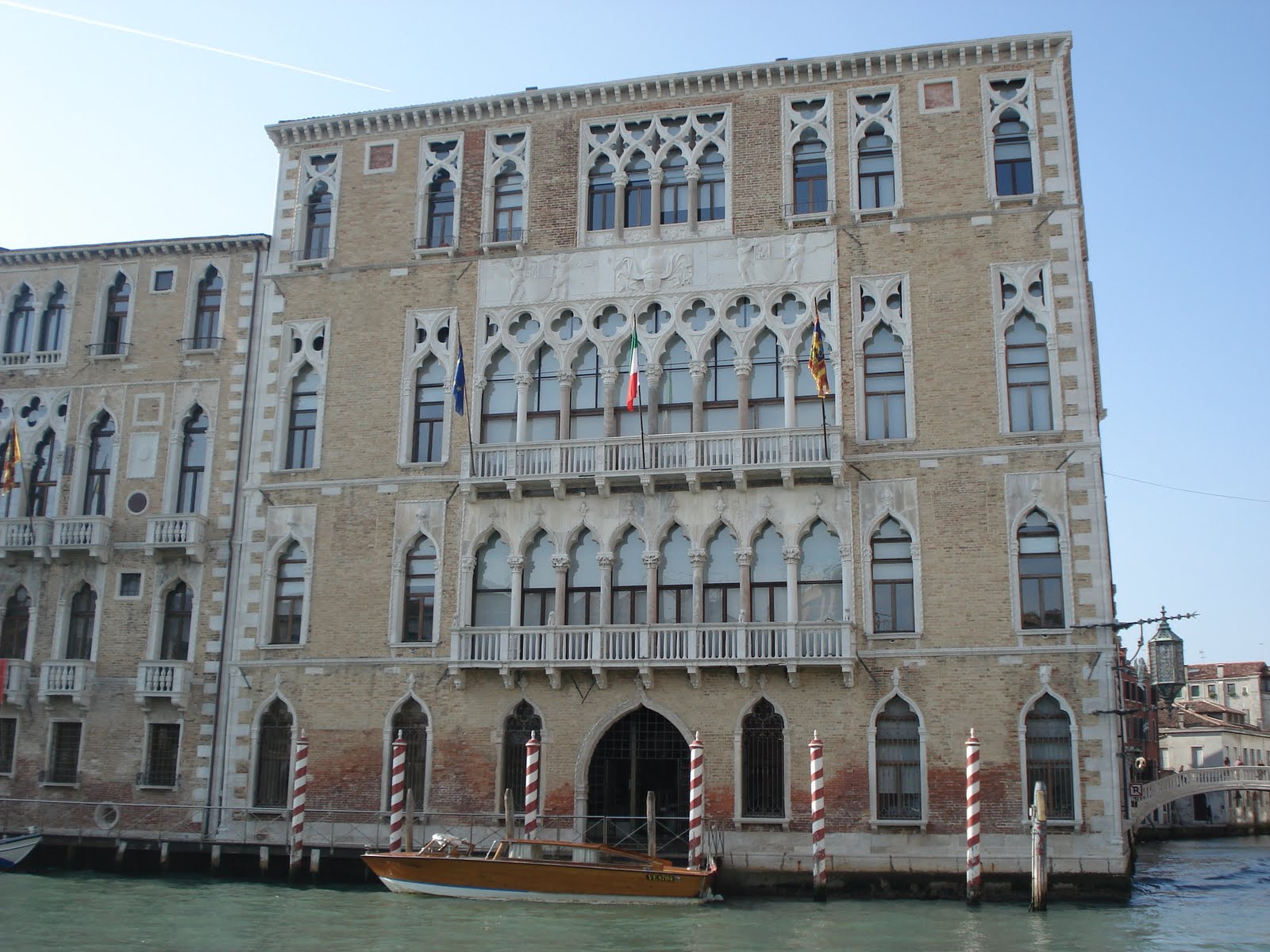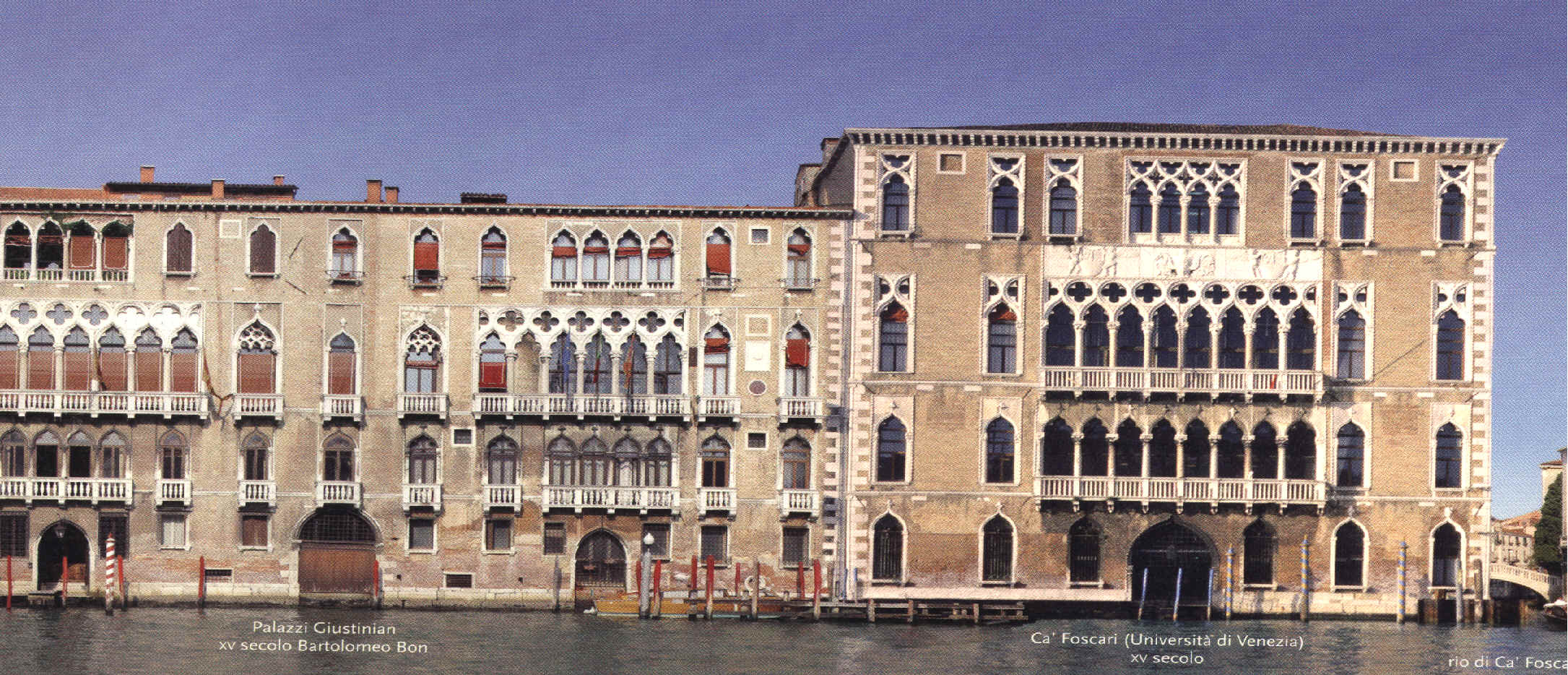Ca' Foscari
, Also called Ca ' Foscari Palazzo Foscari, is a late Gothic palace in Venice, which serves as the seat of the Venetian University. At the time of its construction it was the largest private home in Venice, and together with the adjacent Palazzo Giustinian, with which it forms a contiguous building complex since 1942, the Ca ' Foscari is the largest Gothic palace complex in Venice. It can be visited on a guided tour for consideration.
The palace was often used in the course of its history as accommodation for guests superscript of the Republic of Venice. Among the illustrious guests included 1574, the French King Henry IV
The house offers due to its favorable location at the first bend of the Grand Canal, the so-called volta di Canal, an unusually far-reaching view along the waterway. The view stretches from the Rialto Bridge in the north- east to the Accademia Bridge in the south. Because of its location advantage, the house is storica in September each year, the target point of the Regata.
Description
The palace stands in a prominent position in the Dorsoduro area opposite the Palazzo Balbi and it lies between the Rio di Ca 'Foscari and the Rio di San Barnaba on the right side towards the Bacino di San Marco.
The Ca ' Foscari is a typical example of the late Gothic palaces of the Venetian nobility and wealthy merchants. The ground floor of the four-storey building in the flamboyant style was previously used as a storage room. The first two upper floors were used by the inhabitants as the piano nobile, so for residential purposes and festivities. The top floor is completed by a flat, covered with red tiles roof. The property has two entrances. The input to the channel displayed was once the main entrance. This ogee arch entrance with a garb of light marble is more elaborate than the nearest the street entrance. Similarly, it is with the bare water-side facade. She is - completely symmetrical designed and displays the first and second floor of a marble loggia arcades achtbogigen - with the exception of a frieze. Thus, the two piano nobili be emphasized architecturally. About the Pillars of arcature, which are decorated with foliage, animals and masks, there is a quatrefoil tracery, which is crowned by a marble frieze. Its central motif is a helmet, which is flanked by heraldic shield bearing on both sides putting. The shields show the arms of the Foscari family. The on the land side facing, rear facade is not from the time of construction of the building, but probably only from the late 16th century.
The recently restored roadside portal leads into the large courtyard of the estate, which is completed on two sides by a wall. The yard is after the Palazzo Ducale is the second largest of its kind in Venice.
In the interior, especially the Great Hall on the second floor is remarkable. He died in 1984 the Italian literature professor Mario Baratto dedicated, so it is also called Mario Baratto room. The hall is presented with a interior from the 1930s and 1950s. From the period of the 1930s and the two are hanging in the Great Hall frescoes Venezia, l' Italia e gli studi ( German Venice, Italy and the studies ) by Mario Sironi and La scuola ( German School ) by Mario Deluigi. The latter work was initially located on the first floor, but was then placed in the great hall. It shows a philosopher surrounded by his disciples.
Façade on Calle Foscari
Loggia of the 2nd floor
Gold-plated ceiling from the 16th century
History
At the site of today's palace was formerly called the Casa delle Due Tori ( German House of the Two Towers), the ankaufte the Republic of Venice in 1429 by Bernardo Giustinian to give it to then the Condottiere Gianfrancesco Gonzaga I., Duke of Mantua. After he had changed sides and turned against Venice, in 1439, the building was confiscated and given to Francesco Sforza, I., later the Duke of Milan. As well as this had turned against Venice, the Republic of 1450 pulled it again, and auctioned it in 1452. Buyer was the Doge Francesco Foscari. He had put down the buildings standing there and from 1453 to build a new representative Palazzo, whose elaborate design was appropriate for their level. From his family, the new building acquired its current name. The plans for the building was provided by the Venetian architect Bartolomeo Buon. The construction of the house took several years and was not finished at death Francesco Foscari in 1457.
The Foscari family remained until 1845 owner of the building before they sold it in that year to the Congregation Municipale di Venezia. The following uses, for example in 1849 as Hospital, the historic structure were very detrimental. Also, that the Austrian occupation force used the palace as a barracks, damaged the building - especially inside - very. As 1868, the founding of the Royal School of Economics (Italian Regia Scuola Superiore di Commercio ) was then decided the Ca ' Foscari was intended for their seat.
In the 1930s took place first repair work under the auspices of the Italian architect Carlo Scarpa. Scarpa designed the entrance hall and the Great Hall (Aula Magna ) with the adjacent rooms on the second floor new in 1936. Moreover, the two inputs of the property have been repaired. 1956 Scarpa was engaged again to reshape the Great Hall again. This was destroyed in a 1979 fire in part, but then restored by the architect Valeriano Pastor.
The date the last major restoration work, which also included the Palazzo Giustinian, took place from January 2004 to the summer of 2006. Here, under the large courtyard relics have been found dating from the 9th century and discovered a equipped with frescoes of the 15th century the floor. In addition, in a room on the first floor you put a richly decorated and gilded ceiling from the 16th century free. University students finally restored in 2008, it is an exterior side door of the palace.


.jpg/220px-Ca%2527_Foscari_(Venice).jpg)






